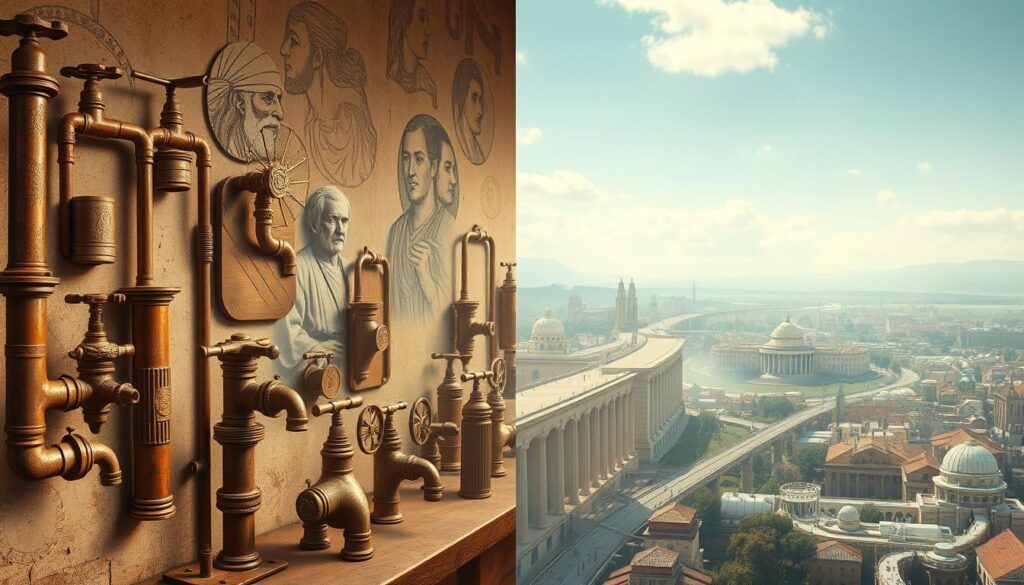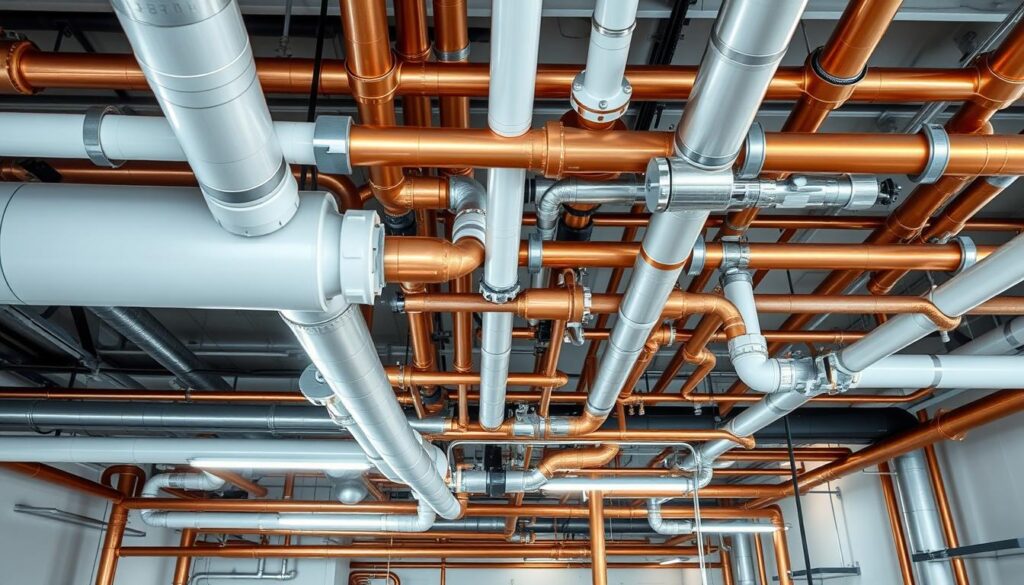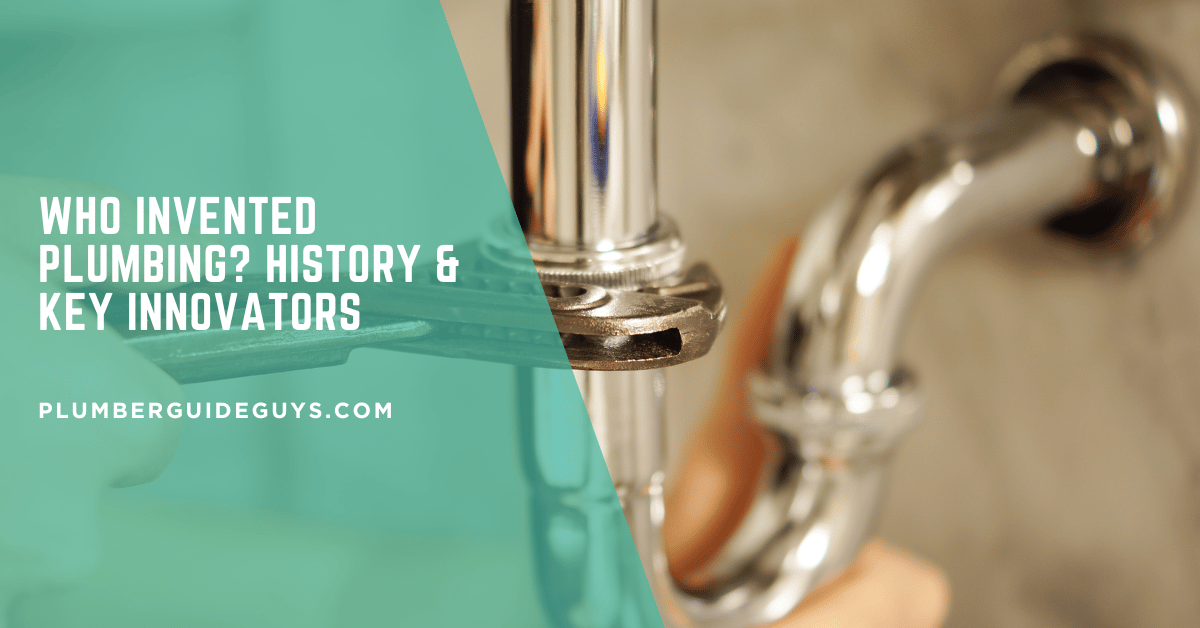Affiliate Disclosure
Plumber Guide Guys is a participant in the Amazon Services LLC Associates Program, an affiliate advertising program designed to provide a means for sites to earn advertising fees by advertising and linking to Amazon.
Who Invented Plumbing? Imagine a world without clean water from your tap or a working toilet. It’s hard to picture, right? The history of indoor plumbing is a journey of human ingenuity. It shows how we’ve changed how we live.

When you think about who invented plumbing, it’s not just one person. It’s a story of many innovations over thousands of years. Ancient societies like the Mesopotamians and Indus Valley civilization started the journey to modern plumbing systems we use today.
The history of indoor plumbing shows humans have always been problem solvers. Water management was key for survival, health, and urban growth.
Key Takeaways
- Plumbing has roots in ancient civilizations dating back 6,000 years
- Water management was critical for human survival and urban development
- Multiple cultures contributed to plumbing innovations
- Early plumbing systems were sophisticated for their time
- The evolution of plumbing reflects human technological progress
Table of Contents
The Birth of Ancient Plumbing Systems
Ancient civilizations were the first to manage water in amazing ways. They created systems for water and sanitation that were way ahead of their time. This shows how smart they were about engineering and health long before we had today’s technology.
These early societies knew how important water was. They came up with clever ways to handle, share, and manage water.
Early Water Management in Mesopotamia
Mesopotamia was a big step forward in water systems. Around 4000 BCE, they made clay sewer pipes. This made city life much better. Their drainage systems showed off their amazing engineering skills:
- Clay pipe networks for waste removal
- Sophisticated urban water distribution
- Advanced drainage infrastructure
*”Water management was the cornerstone of civilization’s progress.”*
Indus Valley’s Revolutionary Sanitation
The Indus Valley Civilization, which flourished around 3000 BCE, had amazing sanitation systems. Their methods were far ahead of their time, with:
- Comprehensive underground drainage networks
- Sophisticated waste management systems
- Centralized water distribution infrastructure
Egyptian Copper Pipe Innovation
The ancient Egyptians made a big leap in plumbing by using copper pipes. Their metal skills helped create strong water systems. These supported farming and city growth.
These early plumbing systems show our long history of improving water and sanitation. It’s clear that humans have always wanted to make life better with better water management.
Roman Empire’s Plumbing Mastery
The Roman Empire changed how people managed water in cities. They created new ways to handle water and waste. Their work set high standards for water systems that lasted for many years.
Roman engineers built amazing water systems. They made long aqueducts to carry water over long distances. They used gravity to make sure cities had fresh water.
- Developed advanced lead pipe (fistulae) technology
- Created extensive urban sewer networks
- Engineered public bath systems
- Implemented sophisticated water distribution mechanisms
The Cloaca Maxima was Rome’s main sewer. It was a huge underground channel. It kept waste away from people, keeping cities clean and healthy.
| Roman Plumbing Innovation | Key Features | Historical Significance |
|---|---|---|
| Aqueducts | Gravity-based water transport | Enabled long-distance water supply |
| Lead Pipes | Durable water distribution | First indoor plumbing systems |
| Sewer Systems | Underground waste management | Improved urban sanitation |
The Romans knew a lot about water systems. Their work is the base of modern plumbing. It shows how smart they were about water.
Who Invented Plumbing: Key Historical Figures
Plumbing innovation has been shaped by many individuals. They changed how we handle water and keep places clean. To learn about plumbing’s history, we must look at the work of early engineers and designers.
Creating plumbing wasn’t done by one person alone. It took many generations working together. Key figures played big roles in improving water management and toilet technology.
Thomas Crapper’s Revolutionary Contributions
Thomas Crapper didn’t invent the flush toilet, but he made big changes. He improved toilet design in the late 19th century. His work helped make indoor plumbing common in Victorian England.
- Improved toilet valve and cistern mechanisms
- Developed advanced drainage systems
- Promoted modern sanitation practices
Isaiah Rogers: Pioneering Modern Plumbing Systems
Isaiah Rogers was a pioneering architect. In 1829, he created the Tremont Hotel’s plumbing system. This set new standards for city infrastructure and cleanliness.
John Giblin’s Flush Design Breakthrough
John Giblin was a key figure in plumbing history. He patented the first “flush down” toilet in 1819. His design was a major step forward in sanitation systems.
| Inventor | Key Contribution | Year |
|---|---|---|
| Thomas Crapper | Improved Toilet Design | 1880s |
| Isaiah Rogers | Hotel Plumbing System | 1829 |
| John Giblin | Flush Down Toilet Patent | 1819 |
These innovators changed plumbing forever. They helped us understand water management and sanitation better in cities.
Evolution of Plumbing Materials
Early plumbing materials have seen big changes over time. From simple beginnings to complex systems, the journey of water supply has been filled with innovation. It shows how technology has grown and improved.
The Romans were the first to use lead pipes, a big step forward in plumbing. These pipes helped create large water networks. But, soon, people realized lead could be harmful to health.
- Wooden pipes emerged in London during the 16th and 17th centuries
- Cast iron became prominent during the Industrial Revolution
- Galvanized steel offered improved durability and corrosion resistance
New materials took over as technology advanced. Copper pipes were a major improvement, lasting longer and working better. Then, plastic materials like PVC and PEX came along, making plumbing even better.
Today, plumbing focuses on safety, efficiency, and being kind to the environment. Each new material brings us closer to better, greener water systems.
“Innovation in plumbing materials reflects humanity’s continuous quest for better living conditions.” – Engineering Historical Review
Medieval Plumbing Developments
The medieval period was a key time for indoor plumbing. New ways to manage water and waste were found. These ideas helped start the modern sanitation systems we use today.
Medieval people knew how important water management was. They came up with clever plumbing solutions, even with the limited technology of the time.
Monastery Water Systems
Monasteries were early leaders in water management. They created advanced systems for water and waste. These included:
- Sophisticated water collection systems
- Intricate drainage networks
- Innovative water filtration techniques
- Underground water channels
Castle Plumbing Innovation
Castles also saw big advances in plumbing. Nobles came up with unique ways to handle waste. Some examples are:
- Vertical shaft toilets called garderobes
- Rainwater collection systems
- Basic sewage disposal methods
Urban Water Management
Medieval cities started to build public water systems. These early efforts aimed to improve water access and sanitation. They helped reduce diseases. The history of indoor plumbing owes a lot to these early steps.
Medieval engineering showed amazing creativity in solving water distribution problems.
Industrial Revolution’s Impact on Plumbing

The Industrial Revolution changed how we manage water and sewage. As cities grew fast, old ways couldn’t keep up. Plumbing became key for keeping people healthy and clean.
Important changes happened during this time:
- Cast iron pipes replaced wooden and clay conduits
- Water treatment plants were established
- Centralized sewage systems became standard
- Hydraulic engineering advanced significantly
Cities like London and New York saw big improvements. Engineers built better networks for clean water. Pressurized systems made city life better.
The way we handle sewage changed a lot back then. Cities started big projects for better systems. This cut down on diseases and made people healthier.
“The Industrial Revolution wasn’t just about machines—it was about creating livable, sustainable urban environments.”
Big tech wins from then help us now. From cast iron to advanced water tech, the Industrial Revolution changed water use.
The Rise of Indoor Plumbing
Indoor plumbing changed how people lived and used water. By the late 1800s, it made homes more convenient and clean. This was a big change for American homes.
Indoor plumbing was a big step in architecture and society. New technologies and better understanding of sanitation made water easier and safer for everyone.
First Residential Systems
First, indoor plumbing was in wealthy homes. These systems cost a lot but showed their worth quickly:
- Copper pipes replaced old wooden ones
- Water heating got better
- Drainage systems got more advanced
Public Building Installations
Public places helped make indoor plumbing common. Government buildings, hospitals, and schools showed off modern water systems.
| Institution Type | Plumbing Adoption Year | Impact |
|---|---|---|
| White House | 1833 | First running water system |
| Major Hotels | 1850-1870 | Standardized indoor bathrooms |
| Public Schools | 1880-1900 | Introduced hygiene standards |
Urban Planning Integration
Cities started to plan for indoor plumbing. Water supply development was key in city planning. It changed how cities were designed and improved public health.
Indoor plumbing was more than just a new technology. It changed what people expected from their homes and communities.
Revolutionary Plumbing Inventions
The history of plumbing is filled with key innovations. These changes have greatly improved how we handle water and keep our living spaces clean. The first toilet and advancements in water supply are major achievements in human technology.
In 1775, Alexander Cumming patented the S-trap. This design changed toilet history. It kept sewer gases out of homes, boosting health and cleanliness.
The S-trap is now a key part of modern toilets.
- S-trap prevents toxic sewer gases from entering living spaces
- Eliminated dangerous odors and possible disease spread
- Set a key standard for bathroom cleanliness
In 1868, Benjamin Waddy Maughan created an instant water heater. This invention let families have hot water whenever they needed it. It greatly changed home life.
| Inventor | Invention | Year | Impact |
|---|---|---|---|
| Alexander Cumming | S-trap Toilet Design | 1775 | Improved Home Sanitation |
| Benjamin Waddy Maughan | Instantaneous Water Heater | 1868 | On-Demand Hot Water |
These plumbing breakthroughs show how one person’s idea can change a whole system. They’ve made our lives more comfortable and clean.
Modern Pipe Systems and Materials
The world of water supply has changed a lot with new technologies and materials. Today’s plumbing systems use advanced solutions. These make them more efficient, durable, and better at what they do.

New technologies have changed the game in plumbing. They offer solutions that meet today’s needs. You’ll see amazing innovations that change how we manage water.
PVC and PEX Innovation
Plastic piping has become a big deal in plumbing. PVC and PEX pipes bring big benefits:
- They resist corrosion well
- They cost less to install
- They are more flexible
- They last longer than old materials
Copper Piping Evolution
Copper is also key in modern plumbing. It’s good against microbes and has a long history. Many choose it for their water systems.
Smart Plumbing Technology
The plumbing future is smart and connected. Now, we have:
- Leak detection in real time
- Monitoring water use
- Control from your phone
- Alerts for maintenance
These new tools are a big step up in water management. They give users and managers more control and efficiency.
Public Health and Sanitation Progress
The creation of sewage systems changed public health a lot. In the late 19th century, science changed how we handle water and prevent diseases.
Germ theory was a big discovery that changed medicine and sanitation. It showed that tiny bugs can cause diseases. This led to big changes in how cities were built and how health was kept.
- Identification of waterborne diseases
- Implementation of modern sewage treatment methods
- Establishment of rigorous sanitation standards
- Development of thorough public health protocols
Cities started spending a lot on better water systems. London’s modern sewage network, made after the Great Stink of 1858, set a global example for city sanitation.
| Period | Key Sanitation Developments | Impact |
|---|---|---|
| 1850-1880 | Germ Theory Discovery | Reduced disease transmission |
| 1880-1900 | Urban Sewage Systems | Improved public health infrastructure |
| 1900-1930 | Advanced Water Treatment | Significantly lower infection rates |
These changes cut down on deaths and made communities healthier. Water management became key for health experts. It changed how we fight diseases.
Sustainable Plumbing Solutions
Modern plumbing is changing how we handle water and sewage. Now, homes and communities can use new, green technologies. These technologies cut down water use and harm to the environment.
Water saving is key in today’s plumbing. Homeowners can use many green ways to cut down on water waste:
- Low-flow fixtures that use less water
- Dual-flush toilet systems
- Rainwater harvesting technologies
- Greywater recycling mechanisms
New water management methods are changing buildings. Intelligent plumbing systems use smart sensors and tools. They track water use in real-time, helping save more water.
| Sustainable Plumbing Technology | Water Savings |
|---|---|
| Low-flow showerheads | 40-60% reduction |
| Dual-flush toilets | 50-70% reduction |
| Rainwater harvesting | Up to 80% non-potable water savings |
Green plumbing is driven by environmental rules. Building codes encourage water-saving designs. This pushes makers and builders to create better water-saving tech.
Water is our most precious resource, and sustainable plumbing shows our care for the planet.
Conclusion
The story of who invented plumbing is truly amazing. It shows how humans have always been creative and advanced. From the first water channels in ancient Mesopotamia to today’s smart home systems, plumbing has changed a lot.
Now, you know that plumbing’s history is thousands of years long. Every civilization added its own ideas, showing that progress is a team effort. People in Egypt, Rome, and the Indus Valley started the water systems we use today.
Thinking about plumbing’s history, we see it’s not just about pipes. It’s about solving human problems. Every new technology shows our constant effort to make life better. Plumbing’s future looks bright, with new, green technologies and smart systems changing how we use water.
Looking to the future, plumbing will keep changing our world. It shows that innovation never stops. From old copper pipes to new PEX technology, plumbing’s story is just beginning.

